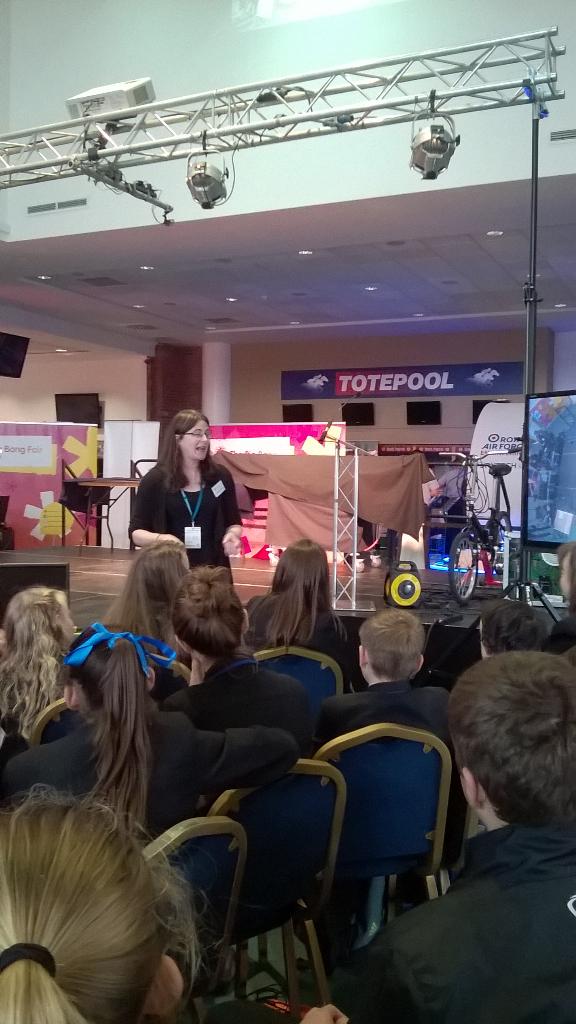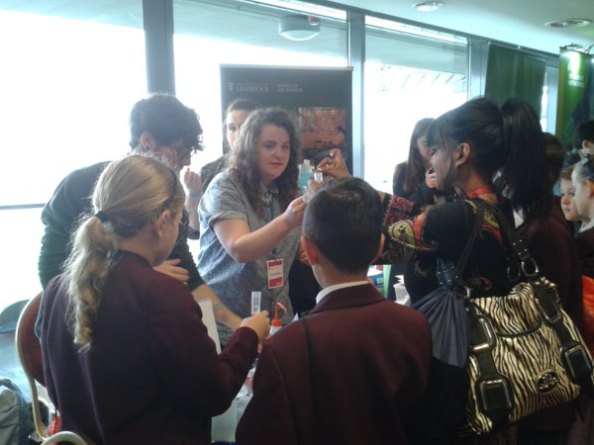by Rebecca Jones
Meet the Scientists on Tour

Meet the Scientists on Tour is an initiative that aims to bring science to the public in places they don’t expect it. Activities centre around magnetic whiteboards where the public can spot caterpillars or match parasite to their hosts. The founders, Klara Wanelik, Rebecca Jones, Gabriel Pedra and Beth Levick have been visiting a number of locations in Liverpool and a folk music festival in Newcastleton where events ran 11am to 3pm. Here’s what they had to say about the events:
St John’s Shopping Centre
The first event was held at St John’s Shopping Centre on the first Bank Holiday Monday (May 1st) and was a success. We engaged with about 40 people although it was so busy we had to work hard to get people to come over to play our activities. It also didn’t help that people thought we were trying to sell them something! We had some great interactions with people though, with comments from participants including: “I really enjoyed the session”, “Caterpillar game – Thank you!” There were also college students asking about studying biology at the University!
.@RSJonesScience and @graviel_pedra still out at @StJohnsShopping, ready to spread some science! #scicomm #mtsot pic.twitter.com/uhaHSyKhqr
— Scientists on tour! (@MTS_OnTour) 1 May 2017
Central Station
Our second event was run on Saturday 6th May at Liverpool Central Station and was very well received. The public passing through the station got stuck in: spotting caterpillars, spreading infection and matching parasites to their animal hosts!
We engaged more people than our last even at St John’s Shopping Centre (approx. 50) and were pleasantly surprised by how positive people were about engaging with our science in such a busy place! The majority of our visitors were young children aged 2-10 years. However, parents seemed equally as interested and we also had a few questions about studying at the University. Comments (from some of our younger participants) included: “I really liked the visit. I hope you come again”, “Really fun and interesting,” and “I liked the games because I learnt things”.
New Mersey Retail Park
Our final event in Liverpool was at the New Mersey Retail Park in Speke on the 29th May. The weather wasn’t great so we were very grateful for our gazebo! Due to the weather we engaged with slightly fewer people (approx. 25) but we had people actively coming over to the gazebo upon recognizing either the University of Liverpool or Meet the Scientists logo. We even had a small girl run into the gazebo exclaiming that she wanted play games in the science tent!
.@MTS_OnTour ready for action @NewMerseychat #scicomm pic.twitter.com/oXXM9IZ9KP
— Rebecca Jones (@RSJonesScience) 29 May 2017
Overall we had a brilliant time across our three locations in Liverpool and are keen to go back and take along some new activities. However, we found that we were mostly engaging with families or the elderly and missed out on the middle age bracket.
Newcastleton Traditional Music Festival
Our most recent location was up in Newcastleton on the Scottish border, close to Kielder Water and Forest Park. We chose this location as Klara is part of a project sampling field voles in Kielder forest and so she was keen to inform the public about what the team was doing. Additionally, we were interested in taking our activities to a music festival as it was a completely new environment for us to do outreach.
We didn’t know what to expect at the festival but it turned out that we were the only stall there and so were able to monopolize the green in the village. On the Saturday (1st July) there were folk music competitions underway but we were able to engage with a large number of local villagers and visitors from further afield. Over both days (4 hours on the Saturday and 1.5 hours on the Sunday) we engaged with a total of 52 members of the public.
Infection control with @klarawanelik in Newcastleton #scicomm pic.twitter.com/odqSHkwJmI
— Scientists on tour! (@MTS_OnTour) 1 July 2017
We had some great interactions with people, many of whom approached us out of curiosity about why the University of Liverpool was present in Kielder. We were also able to interact with people from a broader age range – particularly with people in their 20’s and 30’s. We had a few local farmers come over who were particularly interested in our ‘Where does the parasite live’ activity. Our competitive game where people spread infections in populations proved very popular again at this event. Furthermore, lots of people were interested in the work with the voles that Klara was describing. Overall, we thoroughly enjoyed carrying out our outreach at the folk music festival which was a very different challenge to the locations in Liverpool. Although, after ceilidh dancing into the morning and being attacked by midges in our tent, we were happy to return to Liverpool for some well-deserved rest!
Thanks for having us Newcastleton! Enjoyed the music, dancing and science #scicomm pic.twitter.com/hC3hl2eDIL
— Scientists on tour! (@MTS_OnTour) 2 July 2017
Finally, we would like to say thank you to everyone who helped make ‘Meet the Scientists on Tour’ possible. We’d like to thank the Wellcome Trust for funding us and Laura Winters for her support. We’d also like to thank Vincent Keenan for assisting at the event at Central Station and Steve Paterson for his additional financial (and moral) support. Most importantly, we’d like to thank everyone at the various locations who made it possible (and so enjoyable!) for us to carry out our outreach.
We’re keen to extend our outreach beyond ecology-based activities and so on the 5th July we ran an activity design workshop with attendees from the Victoria Gallery and Museum, Engineering Department and Institute of Translational Medicine. This was a half-day workshop where people had a go at our activities before settling down to design their own. Attendees then had a chance to present their boards, with much discussion in the group. We look forward to welcoming some more activities soon. Watch this space!
Discussion over #scicomm activities pic.twitter.com/UTBNDgcJTD
— Scientists on tour! (@MTS_OnTour) 5 July 2017
If you’re interested in designing an activity or want some more information, contact us on twitter at @MTS_OnTour, or by emailing kwanelik@liv.ac.uk.









 h a group of DEEB students (
h a group of DEEB students (

